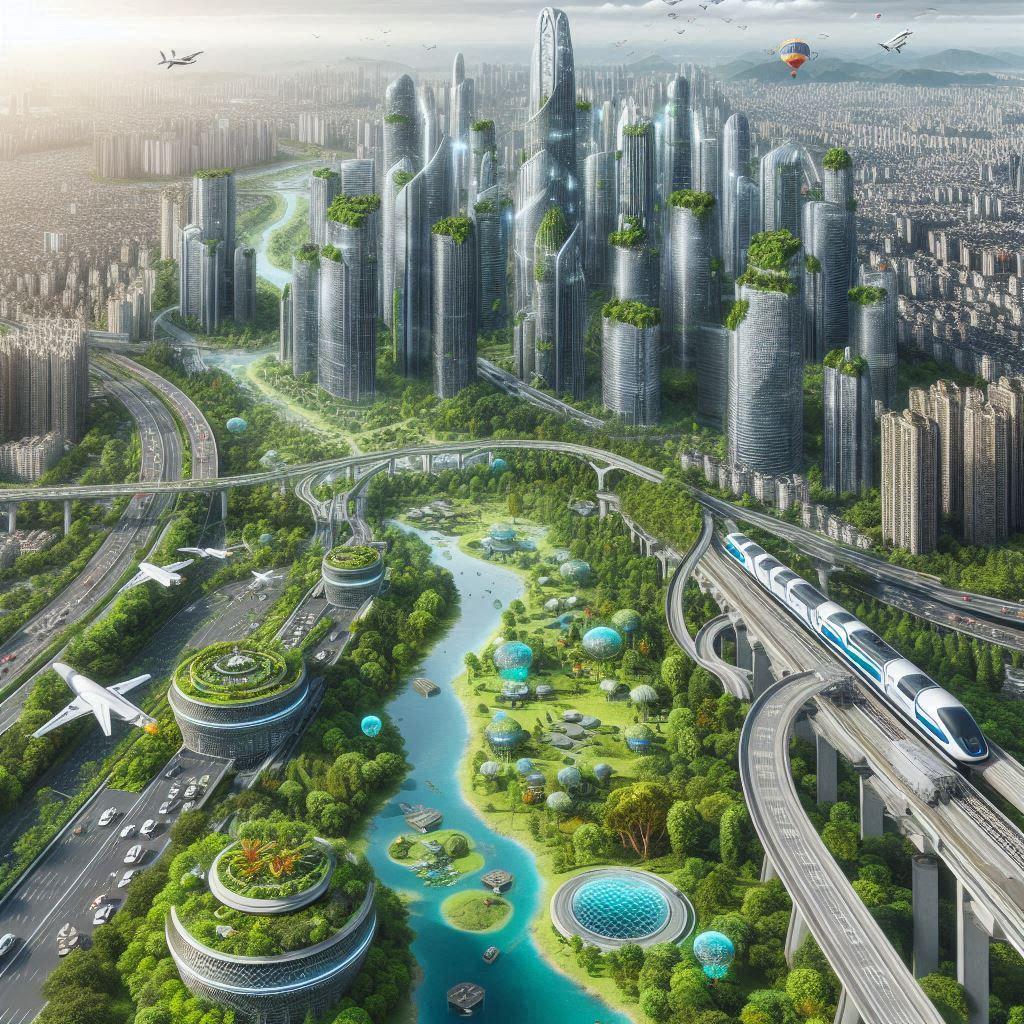The 21st century is witnessing an unprecedented shift in global demographics, with more people than ever before migrating from rural areas to urban centers. This rapid urbanization is giving rise to megacities—urban areas with populations exceeding 10 million. Megacities are not just larger versions of traditional cities; they are complex ecosystems that drive economic growth, cultural exchange, and innovation. However, they also present significant challenges, including social inequality, environmental degradation, and governance issues. This article examines how the rise of megacities is reshaping our world, exploring both the opportunities and challenges they bring.
Economic Transformation and Opportunities
Megacities are often seen as the economic powerhouses of the future. As hubs of commerce, industry, and innovation, they attract businesses and talent from around the world, fueling economic growth on a massive scale. The concentration of resources, infrastructure, and human capital in megacities creates unique opportunities for economic development.
Global Economic Hubs
Many of the world’s megacities, such as Tokyo, New York, and Shanghai, serve as global economic hubs. These cities are centers of finance, trade, and industry, driving both national and international economies. The presence of multinational corporations, financial institutions, and tech companies in these urban areas creates a vibrant economic environment that attracts investment and talent from around the globe.
The agglomeration effect—the economic benefits that arise from businesses and people clustering together—further amplifies the economic power of megacities. As companies and industries congregate in megacities, they benefit from shared resources, knowledge spillovers, and a larger labor pool. This leads to increased productivity and innovation, driving economic growth.
Employment Opportunities and Migration
The economic opportunities available in megacities act as a magnet for people from rural areas and smaller towns. The promise of better employment, higher wages, and improved living standards drives migration to these urban centers. This influx of people contributes to the growth of the city’s labor force, enabling businesses to expand and thrive.
However, this rapid population growth also presents challenges. The demand for jobs often outpaces the supply, leading to issues such as unemployment, underemployment, and informal labor markets. Despite these challenges, megacities continue to be seen as lands of opportunity, where hard work and determination can lead to upward mobility.
Social Challenges and Inequality
While megacities are engines of economic growth, they also magnify social challenges, particularly those related to inequality. The rapid influx of people into urban areas often exacerbates existing social divides, creating stark contrasts between wealth and poverty within the same city.
Urban Poverty and Slums
One of the most visible manifestations of social inequality in megacities is the proliferation of slums and informal settlements. As megacities expand, the demand for affordable housing far exceeds supply, forcing many residents to live in overcrowded, substandard conditions. These informal settlements often lack basic services such as clean water, sanitation, and electricity, contributing to poor health outcomes and reduced quality of life.
The concentration of poverty in certain areas of megacities also contributes to social exclusion and marginalization. Residents of these areas often have limited access to education, healthcare, and economic opportunities, perpetuating cycles of poverty and inequality.
Social Stratification and Segregation
Megacities are often characterized by extreme social stratification, with wealthy elites living in luxurious enclaves while the urban poor struggle to survive in slums and informal settlements. This social divide is further exacerbated by spatial segregation, where different socioeconomic groups live in separate, often disconnected parts of the city.
This segregation can lead to a lack of social cohesion and increased tensions between different groups. In some cases, it can even result in social unrest and conflict. Addressing these social divides is one of the major challenges facing policymakers in megacities.
Environmental Impacts
The rapid growth of megacities has significant environmental implications, both locally and globally. The concentration of people, vehicles, and industries in these urban areas puts immense pressure on the environment, contributing to pollution, resource depletion, and climate change.
Pollution and Public Health
Air pollution is one of the most pressing environmental challenges in megacities. The high density of vehicles, industrial activities, and construction projects contributes to the release of pollutants such as particulate matter, nitrogen oxides, and volatile organic compounds into the air. These pollutants have serious health consequences, leading to respiratory and cardiovascular diseases among urban residents.
Water pollution is another major concern. The lack of adequate sanitation infrastructure in many megacities leads to the contamination of water bodies with untreated sewage and industrial waste. This not only affects the health of residents but also degrades local ecosystems.
Resource Consumption and Waste Management
Megacities are voracious consumers of resources, including water, energy, and food. The high demand for these resources often leads to over-extraction, putting pressure on local environments and contributing to resource scarcity. Additionally, the sheer volume of waste generated by megacities presents significant challenges for waste management systems, leading to issues such as illegal dumping, landfill overflow, and environmental contamination.
Climate Change and Urban Resilience
Megacities are both contributors to and victims of climate change. The concentration of industries, vehicles, and energy consumption in these urban areas leads to high levels of greenhouse gas emissions, contributing to global warming. At the same time, megacities are particularly vulnerable to the impacts of climate change, including rising sea levels, extreme weather events, and heatwaves.
Building resilience to climate change is a critical challenge for megacities. This involves not only reducing greenhouse gas emissions through sustainable urban planning and development but also implementing strategies to adapt to the inevitable impacts of climate change. These strategies may include improving infrastructure to withstand extreme weather, enhancing emergency response systems, and promoting sustainable resource management practices.
Innovative Solutions and Future Prospects
Despite the challenges associated with the rise of megacities, there are also many opportunities to innovate and create more sustainable and livable urban environments. Policymakers, urban planners, and communities are increasingly recognizing the need for new approaches to address the unique challenges of megacities.
Smart Cities and Technological Innovation
One of the most promising developments in the management of megacities is the concept of smart cities. Smart cities leverage technology and data to improve the efficiency and sustainability of urban systems. This includes using sensors and data analytics to optimize traffic flow, reduce energy consumption, and improve public services.
Technological innovation is also playing a key role in addressing environmental challenges. For example, advances in renewable energy, waste management, and green building technologies are helping to reduce the environmental footprint of megacities. Similarly, innovations in transportation, such as electric vehicles and public transit systems, are reducing air pollution and improving urban mobility.
Inclusive Urban Development
Addressing the social challenges of megacities requires a focus on inclusive urban development. This involves ensuring that all residents, regardless of their socioeconomic status, have access to basic services, economic opportunities, and a high quality of life. Policies aimed at reducing inequality, improving access to affordable housing, and promoting social integration are essential for creating more equitable and cohesive urban environments.
Community participation is also critical to the success of inclusive urban development. Engaging residents in the planning and decision-making processes ensures that the needs and priorities of all groups are considered, leading to more effective and sustainable outcomes.
Global Collaboration and Knowledge Sharing
The challenges and opportunities associated with megacities are not confined to individual cities or countries. As more megacities emerge around the world, there is a growing need for global collaboration and knowledge sharing. International organizations, governments, and urban planners can learn from each other’s experiences, sharing best practices and innovative solutions to common challenges.
Conclusion
The rise of megacities is one of the most significant trends of the 21st century, reshaping economies, societies, and the environment on a global scale. While megacities offer immense opportunities for economic growth and innovation, they also present significant challenges that require new approaches to urban planning, governance, and sustainability. By embracing technological innovation, promoting inclusive development, and fostering global collaboration, megacities can become more sustainable, resilient, and livable for the millions of people who call them home.

